Review for Nichijou - My Ordinary Life Collection 1
Introduction
I go from one high school comedy to another. A couple of weeks ago I was mostly watching Hyakko, and this week I partake of Nichijou a.k.a. My Ordinary Life, but that’s where the similarities end. Other than the settings, these are two very different shows. Hyakko was more of a narrative and character based comedy, while Nichijou owes more to the venerable tradition of the sketch show, populating its cast with bizarre characters, placing them in ridiculous situations, and letting the gag writers run riot. It’s based on one of those quick-fire, short form manga, and that blink and you miss it approach is applied to its comedy.
It also comes from the KyoAni studio when they were flying high off the success of K-On! and were in the mood to experiment. In terms of animation style and originality, Nichijou is unlike any other anime I have seen. I watched it originally on Anime on Demand when it was being streamed to the UK (It’s still available on Crunchyroll if you’re interested), and I was instantly smitten, as were many other fans of its anarchic and totally random comedy. Alas that wasn’t the case in Japan, where it failed to find an audience. KyoAni thereafter went back to the established success of K-On!, and began turning out variations on its cute and inconsequential theme. While I love shows like Free! and Tamako Market, I also crave the different and the original. And so it seems do Western audiences.
Nichijou was snapped up when it came to the licensing free for all in 2011. Unfortunately it was snapped up by Bandai Entertainment in the US, just a couple of months before that company closed up shop altogether. Both it and Gosick fell into licensing limbo and have lain their ever since, only their continued presence on Crunchyroll managing to stave off a fan riot. But thankfully Australia knows a good thing when it sees it. Madman Entertainment Down Under licensed both these shows, and released Gosick last year. This year they released Nichijou, and there was no way that I was not going to import it. Selamat Pagi!
Nichijou is really a sketch show, which makes putting a series synopsis together a little pointless. It might be more appropriate to concentrate on the characters, but Nichijou also has an embarrassment of riches here, so describing most of its characters would be prohibitive. For the first half of the series, there are two main areas of focus though, the high school, and the Shinonome Laboratory. The Shinonome Laboratory is home to the Professor, a genius inventor and scientist who also happens to be a little girl, practically an infant. She’s had to invent her own caregiver, a perfectly human looking android named Nano, except for the clockwork key on her back. Nano wants to be a normal girl, but the professor keeps adding optional extras to her design. Like all girls, Nano loves cute things, especially the Professor, but she also picks up a cute cat and brings it home. They name it Sakamoto, and the Professor promptly invents a scarf that allows the cute little kitty to speak. The kitty turns out to be a middle aged male, who realising he’s the oldest in the Laboratory goes about demanding some respect for his authority. He’s Mr Sakamoto, and don’t you forget it.
Meanwhile school focuses on the lives of three friends, Yukko, Mio and Mai. Yukko is the happy go lucky, not altogether smart, but always coming up with wacky ideas member of the group. She’ll also go out of her way to infuriate Mio in some way, but she’ll hit a brick wall when she tries it with Mai. Mio tries to be strait-laced most of the time, but she has an explosive and violent temper that Yukko frequently provokes, and she also likes drawing the kind of manga that she’d rather not share with the class. Mai on the other hand has a propensity for surreal behaviour which is tailored to blow Yukko’s mind, and a discreet streak of sadism hidden behind a quiet and reserved demeanour. There are plenty of other colourful characters in this school, Mio has a crush on Sasahara, a boy who comes from a family of farmers, but considers himself an aristocrat, has a personal servant to attend to his every need, and rides a goat to school every day. He has another relationship with his class representative Misato Tachibana, the ultimate in tsundere who deals with her conflicted feelings for Sasahara by shooting him with various grades of military artillery when he infuriates her. Nakanojo doesn’t have a Mohican, the hair just doesn’t grow at the sides... and the school principal wrestles with deer. It’s just everyday life.
The first thirteen episodes of Nichijou are presented across two discs from Madman Entertainment, seven on disc 1, six plus extras on disc 2.
Picture
Nichijou gets a 1.78:1 anamorphic transfer on these discs. It’s a native PAL conversion, so expect the 4% PAL speed up. The image is clear and sharp throughout, with strong and consistent colour reproduction. Clarity is excellent, there’s no sign of any compression artefacts, except maybe if you pause the discs during moments of frenetic motion on screen, and aliasing was minimal. You’ll have to look for it, but there is a smidge of edge-enhancement that becomes apparent when the show is up-scaled to an HD panel.
Based on a gag manga, the character designs in the show are a little more simplistic, while the colour palette is bright and chirpy without getting garish. There’s also a simplicity in the world design, but there is always significant production value and a level of detail beyond that required for a simple set-up punchline format. The animation is of consistently high quality throughout, fluid and detailed beyond that which you would expect from the artwork style. It’s a show that looks surprisingly good given its genre and it’s consistently pleasing to watch. I really like the segues between scenes, little vignettes of normality shown slightly out of focus.
Sound
Nichijou gets a DD 2.0 Japanese track, with optional translated English subtitles. Be aware that there isn’t an English dub for this show. I have no problems with the audio, the dialogue is clear and audible throughout, there are no problems with glitches or distortion, and the show’s action sequences and music come across with impact. The theme tunes are perfectly suited to the show, quirky and whimsical, while the show’s incidental music gets the orchestral treatment, really well defined musical pieces that almost seem like overkill for the show, but really do help make the material shine. PAL speedup is applied of course, but thankfully I could find no indication of pitch correction (It takes me a few seconds to get used to higher pitched audio, but I can never get used to the clipping and distortion of unsympathetically applied pitch correction).
As for the subtitles, it appears to me that Madman Entertainment merely used the Crunchyroll subtitle script without revision, simply retiming it to the PAL playback. In the early episodes, there are bits of onscreen text that aren’t translated, and those very same bits are just as un-translated in the Crunchyroll streams. The spinning cubes that spell out a phrase are only revealed to read Short Thoughts after episode 5. It’s actually episode 5 that offers the most telling example that these are the Crunchyroll subtitles. At 7 minutes there is a short scene, with two lines that aren’t subtitled. It’s a visual joke anyway, and you will laugh even without the translation, but check the Crunchyroll stream for episode 5, and that scene is absent in its entirety for the broadcast version. It was added for the home video release, and quite obviously was never subtitled.
Extras
You get two discs in an Amaray style case, with one disc held on a central hinged panel, and one at the back. The inner sleeve artwork is a bit of a bonus that’s really nice to look at.
The discs present their content with static menus, and they have jacket pictures that you can see on compatible players when they aren’t spinning.
All of the extras are on disc 2, and unfortunately none of them have subtitles, which make them idle curiosities at best for non-Japanese speakers.
You get 7 minutes worth of Alternative Episode Previews, 3 minutes worth of Japanese Promos, 30 seconds of Japanese Teasers, and 2 minutes of the Japanese TV Commercials.
You also get the textless credits for the show, the first opening and the closing sequences. Unfortunately the audio for the textless opening is out of sync with the video, preceding it by a fraction of a second.
After an anti-piracy thank you, you can take in trailers for other comedy shows from Madman Entertainment, School Rumble, K-On! Season 1, The Melancholy of Haruhi-chan Suzumiya and Nyoron-Churuya San, and Squid Girl: Season 1. You can get the latter three in the UK from Manga Entertainment.
Conclusion
It will probably come as no surprise that I love Nichijou. I did pay for the Australian version after all, added more than a few cubic metres of CO2 into the atmosphere shifting it halfway around the world to partake of its brilliance. But I freely accept that Nichijou is an acquired taste, and one that not everyone may acquire. It’s the anime version of The Fast Show, a quick-fire sketch format where the jokes only work through repetition. In fact my reaction to Nichijou perfectly matched my reaction to The Fast Show. Once more, I watched episode 1, stone-faced, even nonplussed by what was going on, as the characters were introduced and the situations established. Episode 2, and I started to chuckle as the jokes really hit for the first time. By episode 3 I was belly-laughing my way through the episodes, and that established my appreciation for the show.
Nichijou is the comedy for you if you like your laughs on the surreal side, and if you have an appreciation for the extreme overreaction to mundane situations. A simple double-take would be small potatoes for these characters. We’re talking the breathless, hyperventilating shock of a school principal finding a voodoo doll in his shoe locker, the panicked search for rationality when a student is faced with that very same principal wrestling a deer.
Like the average sketch show though, you can’t satisfy all of the people all of the time, and some bits are funnier than others. Of course funny is in the eye of the beholder, but for me, bits like The Igo Soccer Club and the Short Thoughts really are breathers between the jokes, rather than funny themselves. And I still have no idea what Helvetica Standard is all about, aside from it being a manga that one of the characters reads. It’s as if her manga is animated in a section all its own, and maybe the joke is how unfunny it actually is? These are small asides from the main thrust of the comedy though.
That’s split between the high school trio of Yukko, Mio and Mai, and the characters in the Shinonome Laboratory. The Professor, Nano and Sakamoto provide the cute quotient of the laughs. The Professor may be a genius who can create a life-like android (with a roll cake dispenser in her arm), but in every other way she’s just like an eight-year old girl, wanting to play, to eat snacks, to have fun, and throw tantrums when she doesn’t get her own way. Nano is the android who wants to be more human. She is pretty much human in her personality, and her affection for the professor, it’s just the key in her back and the surprise optional extras that keep popping up that cause her consternation. And then there is Sakamoto, the cat, who gains a voice of authority thanks to another of the Professor’s inventions.
There’s more of the surreal and slapstick when it comes to Yukko, Mio and Mai, three totally conflicting personalities that somehow are best friends. Yukko’s dopey optimism is bound to rub Mio the wrong way, Mio’s short fuse sees her erupt in rage at the drop of a hat, while Mai’s quiet surreal streak manifests in the pranks that she plays on her friends. I know that this is pretty much repeating what I wrote in the introduction, but like all short form comedies, you really have to see it to get the joke, trying to explain the humour never works.
There is a little of everything in Nichijou, whether it’s wordplay, slapstick, purely visual humour, lowbrow stuff, or humour more cerebral, and the animators play with different styles and techniques to emphasise the gags, different camera angles, slow motion, and distorted views. It’s also not afraid to do something completely different, such as the beginning of episode 7, which might just be from a different show altogether, until the gag falls into place.
I have to admit that at the end of these thirteen episodes, particularly episodes 10-12, there’s a sense of momentum being lost, of jokes being rehashed, and things being not quite as funny and fresh as before. It’s almost as if Nichijou finds a comfortable groove and falls into it, just doing enough to maintain the status quo. It really needs a change in format to kick things back up a gear and that comes in episode 13, which for one thing is just as laugh out loud funny as the earlier episodes, but also heralds big changes for the second half of the series, as the Professor decides that Nano should go to school. The world of Yukko, Mio and Mai is about to collide with the world of the Professor, Nano and Sakamoto, and the scope for humour is going to expand exponentially. And yes, I ordered Part 2 along with Part 1. Nichijou is an acquired taste, but if you acquire it, it will taste like the best thing since sliced bread. The opportunity to acquire it without investing first is still there, as the show is available to stream at Crunchyroll at the time of writing. I highly recommend that you give it a try.
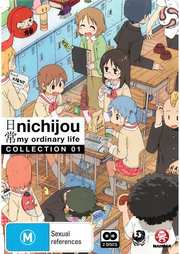
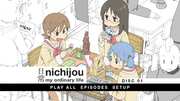

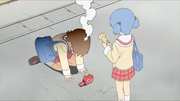
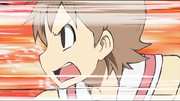


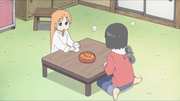


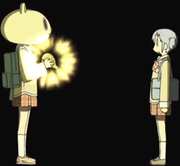
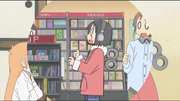

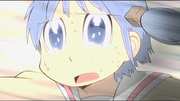
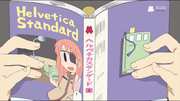















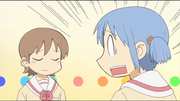






























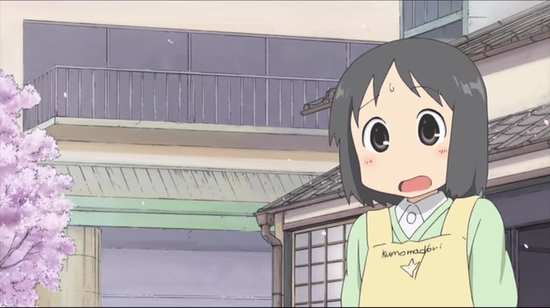









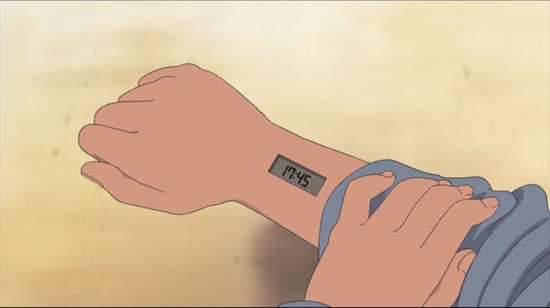




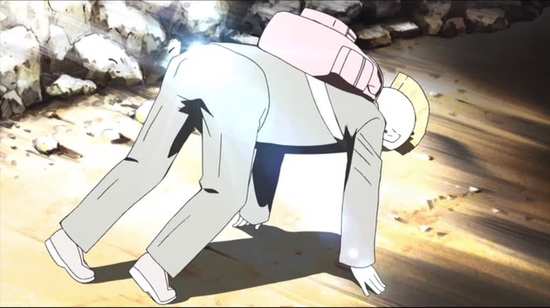

Your Opinions and Comments
Be the first to post a comment!